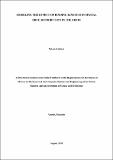| dc.description.abstract | Key factors in the process of drug delivery in the human brain are blood-brain barrier, drug dis tribution and drug binding kinetics. Since human brain is entirely unavailable for experimenta tion, mathematical models have become vital for improved visualization of how each of the key
factors affects the delivery of drugs in the the human brain. In this study, a 3-dimensional math ematical model that incorporates drug transport across the blood-brain barrier, binding kinetics
and drug distribution within the brain extracellular fluid with a bidirectional bulk flow of the
brain extracellular fluid was developed and simulated. The model was developed assuming a
cube volume of a brain unit that is a union of the blood-brain barrier, brain extracellular fluid and
the blood plasma sub-domains. The model includes a set of partial differential equations and
boundary conditions that characterize the processes in the specified sub-domains. To determine
the effect of drug binding kinetics, the model equations together with their prescribed boundary
conditions were discretized by employing the finite difference method implicit schemes and the
model was analysed and simulated using MATLAB coding. Effects of drug binding kinetics
were investigated by varying the binding parameter values for both specific and non-specific
binding sites. All variations of binding parameter values were discussed and the results show
the improved visualization of the effect of binding kinetics in drug distribution within the brain.
For more realistic visualization, it was suggested to integrate more brain components that make
up the large volume of the brain tissue | en_US |

